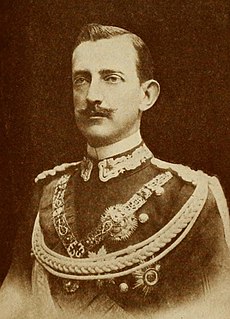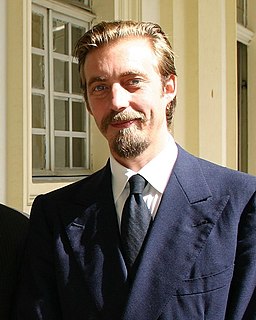
Charles Emmanuel III was the Duke of Savoy and King of Sardinia from 1730 until his death.

The House of Savoy is a royal dynasty that was established in 1003 in the historical Savoy region. Through gradual expansion, the family grew in power from ruling a small Alpine county north-west of Italy to absolute rule of the Kingdom of Sicily in 1713 to 1720, when they were handed over the island of Sardinia, over which they would exercise direct rule from then onward.

Prince Vittorio Emanuele of Savoy, Prince of Naples is the only son of Umberto II, the last King of Italy and his wife Queen Marie-José. Vittorio Emanuele also uses the title Duke of Savoy and claims the headship of the House of Savoy. These claims are disputed by supporters of his third cousin, Prince Amedeo, 5th Duke of Aosta.

Amadeo I was an Italian prince who reigned as king of Spain from 1870 to 1873. The only king of Spain from the House of Savoy, he was the second son of King Vittorio Emanuele II of Italy and was known for most of his life as the Duke of Aosta.

King of Italy was the title given to the ruler of the Kingdom of Italy after the fall of the Western Roman Empire. The first to take the title was Odoacer, a barbarian military leader, in the late 5th century, followed by the Ostrogothic kings up to the mid-6th century. With the Frankish conquest of Italy in the 8th century, the Carolingians assumed the title, which was maintained by subsequent Holy Roman Emperors throughout the Middle Ages. The last Emperor to claim the title was Charles V in the 16th century. During this period, the holders of the title were crowned with the Iron Crown of Lombardy.

Prince Aimone, 4th Duke of Aosta was a prince of Italy's reigning House of Savoy and an officer of the Royal Italian Navy. The second son of Prince Emanuele Filiberto, Duke of Aosta he was granted the title Duke of Spoleto on 22 September 1904. He inherited the title Duke of Aosta on 3 March 1942 following the death of his brother Prince Amedeo, in a British prisoner of war camp in Nairobi.

Prince Luigi Amedeo, Duke of the Abruzzi was an Italian mountaineer and explorer, briefly Infante of Spain as son of Amadeo I of Spain, member of the royal House of Savoy and cousin of the Italian King Victor Emmanuel III. He is known for his Arctic explorations and for his mountaineering expeditions, particularly to Mount Saint Elias (Alaska–Yukon) and K2 (Pakistan–China). He also served as an Italian admiral during World War I. He created the homonymous village in Italian Somalia during his last years of life.

In the mid-13th century the Holy Roman Emperor, Frederick II, made the County of Aosta a duchy; its arms were carried in the Savoyard coat of arms until the unification of Italy in 1870. The region remained part of Savoy lands, with the exception of a French occupation, 1539–1563. The title Duke of Aosta was given to various princes of the dynasty of Sardinia, second sons of the reigning monarch. It can be compared to the English Duke of York, French Duke of Orléans, Swedish Duke of Södermanland and the Scottish Duke of Albany. It remained in the branch of Prince Amedeo of Savoia, the second son of king Victor Emanuel II of Italy, as he was the first ever cadet prince Duke of Aosta who left male heirs. The subsidiary titles of the Duke of Aosta are, from the heritage of Maria Vittoria dal Pozzo, the mother of Duke Emanuele Filiberto, Prince della Cisterna and of Belriguardo, Marquess of Voghera, and Count of Ponderano. Ponderano was created in 1559, Voghera in 1618; Cisterna and Belriguardo as princely in 1670. The title has been used since July 2006 by Amedeo's son Prince Aimone, Duke of Apulia, who is married to Princess Olga of Greece, younger daughter of Prince Michael of Greece and Denmark.

Prince Amedeo, 3rd Duke of Aosta was the third Duke of Aosta and a first cousin, once removed of the King of Italy, Victor Emmanuel III. During World War II, he was the Italian Viceroy of Italian East Africa.

Prince Amedeo, 5th Duke of Aosta is a claimant to the headship of the House of Savoy, the family which ruled Italy from 1861 to 1946. Until 7 July 2006, Amedeo was styled Duke of Aosta; on that date he declared himself Duke of Savoy, a title that is disputed between him and his third cousin, Vittorio Emanuele, Prince of Naples.

Prince Emanuele Filiberto of Savoy, Prince of Venice, usually called Emanuele Filiberto di Savoia, is a member of the House of Savoy. He is the son and heir of Vittorio Emanuele di Savoia and only male-line grandson of Umberto II, the last King of Italy. In his latter days, Umberto II created and gave the title of "Prince of Venice" to his grandson Emanuele Filiberto, but as heir-apparent to the disputed headship of the House of Savoy, Emanuele Filiberto also styles himself as "Prince of Piedmont".

Prince Emanuele Filiberto, 2nd Duke of Aosta was an Italian general and member of the House of Savoy, as the son of Amadeo I, and was also a cousin of Victor Emmanuel III of Italy. Filiberto was also commander of the Italian Third Army during World War I, which earned him the title of the "Undefeated Duke". After the war he became a Marshal of Italy.

Prince Aimone of Savoy-Aosta, Duke of Aosta is the second child and first son of Prince Amedeo, 5th Duke of Aosta, one of the two claimants to the former throne of Italy. In 2006, his father declared himself Duke of Savoy and head of the House of Savoy; since then Prince Aimone has styled himself Duke of Aosta. However, because the headship of the royal house is disputed between his father and Vittorio Emanuele, Prince of Naples, he is still referred to as Duke of Apulia.

Stupinigi, with some 200 inhabitants, is today a hamlet of the comune of Nichelino, in the Metropolitan City of Turin. It borders with the comuni (municipalities) of Candiolo and Orbassano on the southwestern outskirts of Turin, about 10 km from the centre of the city. Before 1869, it formed part of the comune of Vinovo.

Maria Vittoria dal Pozzo was an Italian noblewoman and became the 6th Princess of La Cisterna after the death of her father. Married to Prince Amadeo of Savoy, Duke of Aosta, second son of King Victor Emmanuel. In 1870 her husband became the King of Spain, making her Queen consort of Spain.
Prince Emanuele may refer to:

Princess Olga, Duchess of Apulia is the daughter of author Prince Michael of Greece and Denmark and his wife, Marina Karella, an artist and daughter of the Greek business magnate Theodore Karella. Princess Olga is the wife of her third cousin Prince Aimone of Savoy-Aosta, Duke of Aosta.

Princess Bona of Savoy-Genoa, later Princess Bona of Bavaria, was a daughter of Prince Thomas, Duke of Genoa and Princess Isabella of Bavaria.

Princess Claude of Orléans is a French princess of the House of Orléans. She is the former wife of Prince Amedeo, Duke of Aosta, a disputed head of the House of Savoy.
















